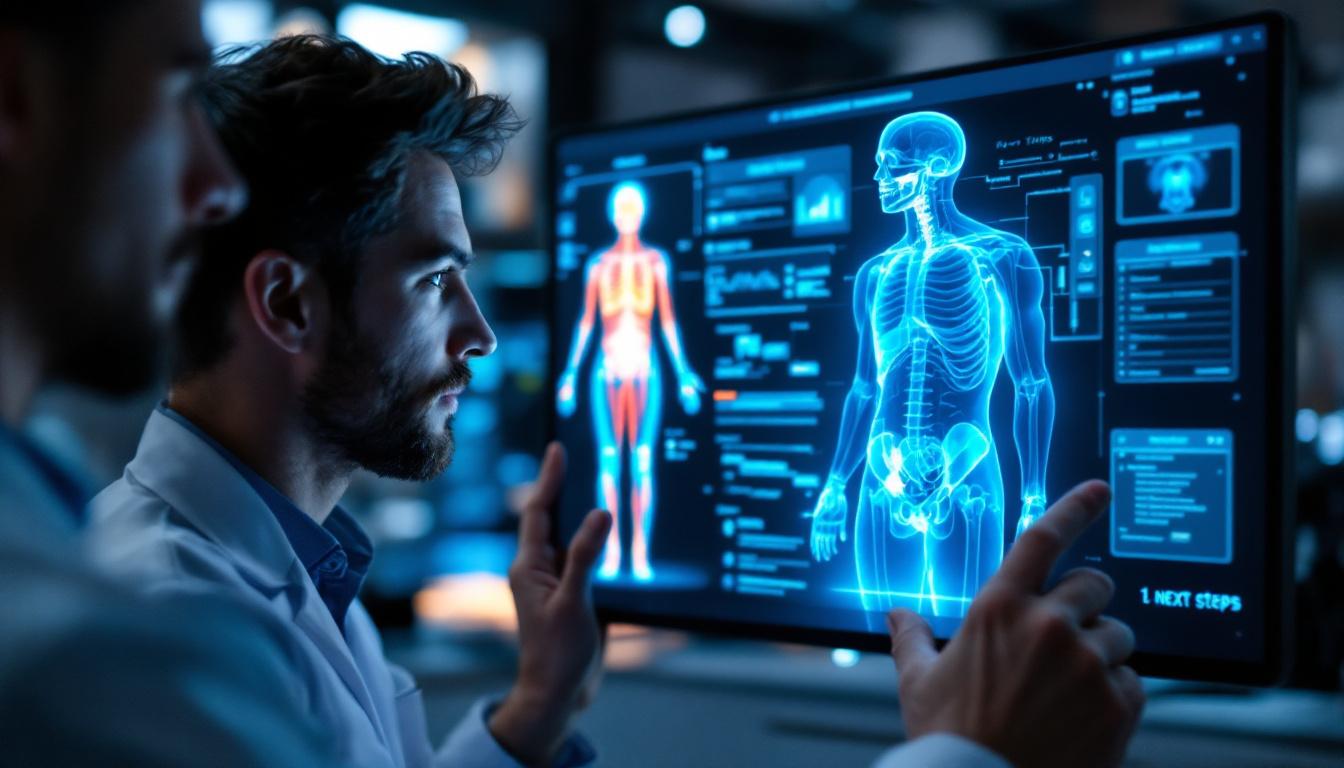%20(1)%20(1).png)
Digital twin technology—virtual replicas of individuals that mirror physiological, behavioral, and environmental data—has moved from engineering labs into clinics and consumer health platforms. By combining continuous data streams, advanced simulations, and machine learning, digital twins promise more precise diagnoses, optimized treatment plans, and proactive disease prevention. This article examines market trends, technological underpinnings, clinical use cases, and the main barriers that must be addressed for widespread adoption.
Market momentum and what it means for care
The healthcare digital twins market is expanding rapidly, driven by increasing investment in AI, sensor technology, and precision medicine. Industry analysis estimated the market at roughly USD 1.3 billion in 2023, with forecasts pointing to continued growth through the decade; the personalized medicine segment alone generated about USD 247 million in 2024 and is expected to grow strongly into 2030. These projections reflect both commercial interest and growing clinical pilot programs that demonstrate tangible value.
Rapid market growth implies that payers, providers, and device makers will increasingly encounter digital twin solutions. For health systems, this translates into opportunities to reduce hospitalizations, tailor interventions, and shift some care from reactive to preventive models—provided regulatory, reimbursement, and interoperability hurdles are addressed.
How digital twins work: data, models, and feedback loops
At the core of any digital twin is a multilayered model that maps physiological structure and function (for example, organ models or metabolic pathways) onto an individual's real-time and historical data. Inputs commonly include electronic health record (EHR) data, imaging, genomics, and continuous sensor feeds from wearables and home devices.
Machine learning and mechanistic simulations update the virtual model as new data arrive. This creates a closed-loop system: the twin predicts outcomes (such as risk of a glycemic spike), the clinician or automated system recommends an intervention, and subsequent data confirm whether the intervention achieved the desired effect—allowing the twin to learn and improve over time.
Key technologies enabling digital twins
Three technology trends are central to current progress: AI/ML for predictive analytics, IoT for continuous monitoring, and cloud-native platforms for scalable simulation. AI enhances pattern recognition and forecasting—useful for anticipating exacerbations or medication responses—while IoT devices supply the continuous measurements that make a twin truly individualized.
Integrating these capabilities requires robust data pipelines and standards-based interoperability so that models can draw from diverse sources without introducing bias or data gaps. Platforms that combine real-time streaming, secure storage, and explainable AI are becoming a necessary foundation for clinically viable twins.
Clinical applications transforming care
Digital twins are being piloted across a range of clinical domains where individualized dynamics matter most—metabolism, cardiology, respiratory disease, and complex multimorbidity management. Use cases show consistent themes: improved personalization of therapy, earlier detection of deterioration, and enhanced patient engagement through actionable insights.
Personalized metabolic and women’s health interventions
Advanced metabolic twins model an individual’s unique glucose, lipid, and hormonal dynamics to recommend lifestyle or pharmacologic interventions. Commercial programs now use continuous sensor data and behavioral signals to tune recommendations, aiming to prevent obesity, prediabetes, and Type 2 diabetes by anticipating metabolic responses.
Particularly in women’s health, digital twins are emerging as tools to fill knowledge gaps in physiology and chronic disease manifestations. Reporting on industry developments highlights companies using sensor-driven models to address female-specific metabolic and chronic disease patterns, offering more tailored prevention and management strategies. For a recent overview of this trend in women's health, see reporting by Axios on how AI-driven twins could help close existing care gaps: How AI "twins" could help fill women's health gap.
Chronic disease management and acute risk prediction
Chronic conditions—like heart failure, COPD, and diabetes—benefit from continuous risk stratification. Digital twins can simulate disease trajectories under different interventions, allowing clinicians to compare potential outcomes for medication adjustments, device settings, or lifestyle changes. This approach has shown promise in reducing exacerbations and optimizing therapy adherence.
For instance, combining physiologic models with wearables makes it possible to detect early signs of deterioration and trigger timely outpatient interventions, reducing emergency admissions. Broader reviews of healthcare digital twin trends describe these applications and the role of AI and IoT in enabling them: Digital twins in healthcare: trends and transformations.
Challenges: privacy, regulation, and practical deployment
Adoption faces non-trivial barriers. Data privacy and security rank high—digital twins require large volumes of sensitive personal data, and models must be protected against breaches and adversarial manipulation. Regulatory frameworks are still catching up; clear pathways are needed for clinical validation, safety assessment, and labeling when algorithm-driven recommendations influence care.
Interoperability and standards are equally important. Without consistent data formats and validated interfaces between devices, EHRs, and modeling platforms, twins will struggle to scale. Recent academic work emphasizes a multidisciplinary approach that includes clinicians, engineers, ethicists, patients, and regulators to navigate these complexities: Stakeholder-sensitive approaches to digital twin adoption.
Ethical and equity considerations
Digital twins can exacerbate health inequities if training data underrepresent certain populations or if access to the necessary devices is limited by socioeconomic factors. Ethical deployment requires transparent model performance reporting across demographic groups, community engagement during design, and pricing or distribution models that prevent widening disparities.
Explainability also matters: clinicians and patients must understand the basis for twin-generated recommendations to maintain trust and facilitate shared decision-making. Regulatory guidance and industry best practices for interpretable AI will play a central role in making twins clinically acceptable.
What healthcare leaders should consider now
Organizations exploring digital twins should prioritize pilot studies that address a clear clinical question, measure outcomes relevant to patients and payers, and plan for integration with existing workflows. Strong data governance, stakeholder engagement, and partnerships with validated technology providers reduce implementation risk.
Additionally, payers and policymakers should evaluate reimbursement models that reward preventive care enabled by digital twins, fostering alignment between clinical value and financial incentives. For a broader market perspective and growth projections, consult industry analysis covering market size and personalized medicine forecasts: Grand View Research: healthcare digital twins market.
Looking ahead: realistic expectations and next steps
Digital twins are not a panacea, but they are a powerful tool for precision care when applied thoughtfully. Near-term gains will come from targeted applications—metabolic management, chronic disease monitoring, and perioperative planning—where data availability and clinical impact align. As evidence accumulates and standards mature, twins could become foundational to personalized medicine architectures.

For readers who want a concise introduction to the scientific conversation around digital twins and medicine, a feature in Time offers useful context on how researchers view the technology's potential: Why some scientists believe the future of medicine lies in creating digital twins.
Conclusion
Digital twins blend continuous monitoring, predictive models, and individualized simulation to reshape how care is planned and delivered. Realizing their promise will require coordinated progress on technology, regulation, equity, and clinical validation. With careful deployment, digital twins can support more proactive, precise, and patient-centered healthcare—transforming prevention and treatment across diverse clinical domains.
References and further reading: Grand View Research market report, Axios coverage on women's health, Time feature on medical twins, and technical perspectives on implementation challenges (Grand View Research, Axios, Time, arXiv).
Related posts
The operating system for value-based care
And experience the impact of telemedicine within your organisation





%20(1)%20(1).png)